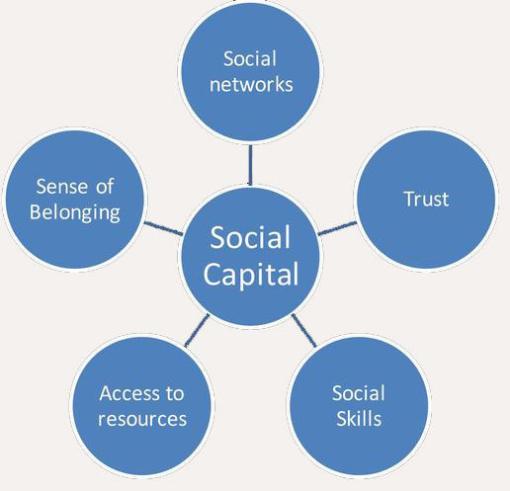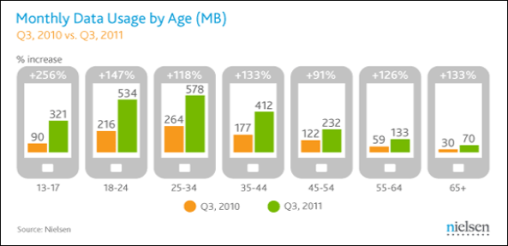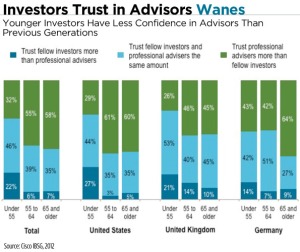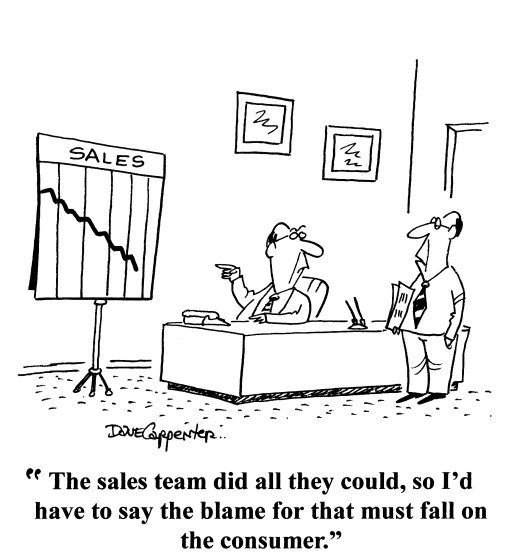The Enrollment Challenge
Retirement readiness decisions are a daunting task for most employees. According to a 2012 Participant Engagement Study conducted by Lincoln Financial:
- 41 percent of employees are only somewhat engaged or fully disengaged from any retirement plan
- 7 percent of employees only are fully engaged and interact with their retirement plan on a regular basis.
Plan communication and education can provide people with the financial knowledge needed to better understand their employee benefits and make better enrollment decisions to achieve better outcomes.
Communication Is Key
The U.S. Employee Benefits Security Administration’s ERISA Advisory Council published a key report in 2010 on how plan communication practices and design options impact participation and contribution rates. They researched strategies for tailoring communications to different subgroups of employees through direct communication, and their effectiveness in influencing participants of diverse demographic market segments, including segments categorized by income level, household status, generation, gender, and ethnicity.
The report then provided recommendations of best practices for enrollment that are statistically proven to be effective, including education to plan sponsors on specific proven techniques and communication practices. In evaluating what communication methods are most effective in encouraging participants to save for retirement, the following considerations were made:
- Cost: an effort was made to balance the need for comprehensive plan communications against cost.
- Delivery: A variety of methods were explored including the use of current and emerging social media.
- Plan Design: The study reviewed how plan designs relate to increasing participant enrollment and savings. In particular, the Council studied the use of automatic features. Automatic enrollment plans automatically choose the employees’ contribution percentage and enroll the participant in an investment vehicle. This raises participation rates to close to 90 percent. However employees enrolled at low contribution rates of 3% or less tend not to deeply consider or increase their contributions.
9 Recommendations and Best Practices
The Council found that effective plan communication and education can provide people with the financial knowledge needed to understand their employee benefits, make better financial decisions, and achieve better outcomes.
Given that the most successful plan communications make use of many channels from print to external websites, online tools, social media, and creative marketing, the Council highlighted best practices that balance personalized, targeted content to help employees evaluate benefit offerings with cost efficiency. They highlighted specific techniques and communication practices that have been statistically proven to be effective in increasing the involvement of employees in saving for retirement. The following are 9 recommendations:
- Communications tailored to particular segments drive results
- One-on-one or small group meetings increase participation
- Immediate “on the spot” communication is most effective
- Short, simple and focused communication drives participant response
- Multiple “touches” with various creative formats increase participation
- Increased technology use is effective and cost efficient
- Behavioral economics and “social norming” can increase participant involvement and savings
- Incentives given by sponsors and “gamification” help trigger participant involvement
- Responsive marketing principles may assist plan sponsors in improving communications
Here is a brief synopsis of these 9 practical recommendations and some best practices:
1. Communications Tailored to Particular Segments
 The Council found that communications that target participants based on their interests, background, and/or economic status were more successful than the “one size fits all” approach.
The Council found that communications that target participants based on their interests, background, and/or economic status were more successful than the “one size fits all” approach.
Understanding the culture and background of the workforce being targeted is key. For instance, since Hispanics will soon constitute one-third of the US population, Council member Donna MacFarland of Lincoln Financial Group stated that in her experience education materials typically are translated from English to Spanish, whereas she recommended that sponsors design the material using the reverse approach, developing materials first in Spanish to address specific cultural needs and language differences.
Human Resource professionals also have found that allowing employees to map out an action plan rooted in realistic scenarios is an extremely effective tool. Some plan sponsors have successfully used a “three-pronged” approach to reach out to their participants by combining simple income replacement projections, behavioral finance strategies and a personalized message. For example, JP Morgan developed 36 different personas based on three age groups (younger than age 30, age 30-50 and older than 50). The firm also targeted participants based upon their regional median income (e.g., Kansas’ median income is $30,000 while in New York City it is $70,000). The basis for this approach was to enable these groups to compare themselves against their peers and take the appropriate action toward saving for retirement.
By narrowly tailoring their target audience on behalf of the plan sponsors that retained them, JP Morgan subsequently monitored whether employees opened their email communications and took action toward saving for retirement. If the individual took action, that person was considered “active,” while someone who opened the email but did not take action was considered “interested.” Based upon the action taken by the individual, the participant received specifically targeted information. This technique resulted in three to four times the response rate of participants who were not targeted.
However, some witnesses advised that there is a general concern regarding the use of targeted communications because complex data collection may provide gender or ethnic identification. Thus, there is concern over whether specific segments identified based upon race or gender could raise discrimination or deferential treatment issues. The Council heard testimony from Donna MacFarland of Lincoln Financial and Thomas Ryan of Fidelity that the use of particularly sensitive demographic information causes concern among plan sponsors. There are also practical concerns about housing information technology. Nevertheless, the overwhelming opinion received during testimony was that targeted communications work.
Branding helps targeting through the use of communications that include a unique positive image that is the group can relate to.
Here are some best practices of participant-centric communication methods:
- Best Practice 1 – The Power of Example: Trustees of the Elevator Constructors 401(k) Plan used materials featuring the story of three employees who made different savings decisions during their careers. The narrative of the three employees was used throughout one-on-one sessions with printed materials to demonstrate how a 401(k) contribution would benefit participants in a variety of circumstances including temporary layoffs, hardships and early retirement. As a result, plan participation rates increased from 26.56 percent to 29.82 percent in 2011. The plan also experienced an 85 percent increase in plan activity from meeting attendees.
- Best Practice 2 – Employer/Employee-Centric Content: M.A. Mortenson Company, an international construction firm, employed construction-related themes in its financial education to engage participants and foster pride in the company. Financial education was made mandatory and workshops were divided by career stage, age, and gender. The plan sponsor focused on participants’ preferences by surveying them after the workshop and making recommendations based on their feedback to yield desired results.
- Best Practice 3 – Bilingual: Consolidated Citrus Limited Partners wanted to 1) increase attendance at plan educational meetings, 2) increase plan participation, 3) increase deferral rates and 4 encourage participants to maximize their match. Ninety percent of the workers spoke only Spanish, and the majority of their day was spent in the orange groves. An in-language campaign was initiated. The company’s Spanish speaking leaders met with small groups in the orange groves. Straightforward collateral in both Spanish and English Collateral were available on site, including announcement posters. By bringing the meetings to the employees, 95 percent of the targeted group attended the meetings. Plan participation increased from 40 percent to 75 percent and deferrals expanded from 4 percent to 8 percent.
- Best Practice 4 – Branding: The Animation Guild 401(k) Plan was implemented for artists working at Southern California animation studios. The sponsors worked with the Guild’s representatives to obtain insights and develop a branded communication urging participants to remember to enroll. The response rate increased over eight percent from the previous year, with 135 new enrollees. Another employer cited in the research increased participation by 30 percent by keeping the message fun, simple and “cool” to target younger workers.
- Best Practice 5 – Multicultural: The Four Seasons 401(k) Plan needed to convey an important plan change to an employer profit sharing employer matching contribution. The sponsor obtained feedback from bilingual meeting presenters in designing the campaign, and provided materials tailored to Hispanics and presentations also were created in Spanish designed to be culturally and linguistically accurate. As a result, the average deferral rate of the targeted group rose from 2.9 percent to 5 percent, and significantly increased beneficiary designations.
2. One-on-One or Small Group Meetings
 After a study by Lincoln Financial found that 66% of participants prefer one-on-one guidance, Lincoln made it a component of its financial education model. They found that the need for individualized information is particularly acute for groups with low participation rates, including women and minorities. Various studies have shown good enrollment and contribution results when employees request in-person group workshops facilitated by financial experts.
After a study by Lincoln Financial found that 66% of participants prefer one-on-one guidance, Lincoln made it a component of its financial education model. They found that the need for individualized information is particularly acute for groups with low participation rates, including women and minorities. Various studies have shown good enrollment and contribution results when employees request in-person group workshops facilitated by financial experts.
- Best Practice for One-on-One Meetings:In 2012, MassMutual representatives spoke with 150,000 employees in face-to-face meetings. Forty-six percent of these individuals took action to improve their retirement readiness and, in one-on-one meetings, 75 percent of employees took action.
- Best Practice for Small Group Meetings: Costs and timing may prevent plan sponsors from providing one-on-one meetings, but small group meetings and audience segmentation have also been successful. The FINRA funded Nurses Investor Education Project had small group meetings for well-educated nurses interested in taking action toward their retirement. They found that generally, the nurses’ lack of basic knowledge, or their perception that they did not know enough to attend these sessions, prevented them from attending their plan sponsor’s meetings. As a result of using small group meetings as a forum, the nurses perceptions changed and attendance at their employer’s retirement plan sessions improved.
3. Immediate “on the spot” Communication
 The ability for participants to take action at the time they are thinking about retirement savings is more effective in increasing enrollment. For example, having computers in the room at the time employees are learning about the plan would allow them to sign up and take immediate action.
The ability for participants to take action at the time they are thinking about retirement savings is more effective in increasing enrollment. For example, having computers in the room at the time employees are learning about the plan would allow them to sign up and take immediate action.
- Best Practice: A US Army mandatory financial management course found that providing the enrollment forms for the Thrift Savings Plan during the financial management course resulted in a sizeable increase in participation, with soldiers signing up for the Plan before leaving the classroom.
4. Short, Simple, Focused Communication
 Behavioral studies show that the most effective communications use simple, straightforward language specific to a participant’s personal situation.
Behavioral studies show that the most effective communications use simple, straightforward language specific to a participant’s personal situation.
- Best Practice: Time constraints mean that any impediments to action should be identified and mitigated. For example, on a website, any extra step, such as the need to retrieve a PIN, may prevent employees from taking action. Solutions include sending the PIN directly to their email account or a mobile number, or mailing a postcard with the website’s uniform resource locator (URL).
5. Multiple Touches With Various Creative Formats
 Consistent, continuous and on-going meaningful communication can be achieved by repeatedly sending out simplified mailings. Social media can help alleviate the cost of additional touch points, and yet, few companies use social media channels for retirement information.
Consistent, continuous and on-going meaningful communication can be achieved by repeatedly sending out simplified mailings. Social media can help alleviate the cost of additional touch points, and yet, few companies use social media channels for retirement information.
- Best Practice: The Council’s Professor Madrian cites a company in which the third mailing of a simplified reply form requiring the checking of a box to enroll doubled enrollment from 22 percent to 45 percent of non-participating employees.
6. Cost Effective Technology
 Every demographic group is now using the Internet as a preferred source of information, via home computer or mobile devices. In addition, electronic media provides the ability to track responses, which is unavailable when the communication is sent through printed materials and regular mail. Another cost effective technological advance is Dynamic Page Publishing, reviewed at the conclusion of this article.
Every demographic group is now using the Internet as a preferred source of information, via home computer or mobile devices. In addition, electronic media provides the ability to track responses, which is unavailable when the communication is sent through printed materials and regular mail. Another cost effective technological advance is Dynamic Page Publishing, reviewed at the conclusion of this article.
A Deloitte study in 2012 that found:
- 93 percent of Americans place Internet access as the most valued household subscription;
- 54 percent of Americans own smartphones, and the rate is increasing 29 percent annually.
- One of three Americans over age 50 has downloaded an application to a smartphone, and 28 percent access their bank accounts via smartphone.
Engaging Millennials: Electronic media is the most effective method of communication to engage younger generations in retirement planning, including Generation X (born between 1965 and 1979). In order to combat inertia caused by competing financial priorities, such as student loan debt, it is important for this group to be engaged through “YouTube” videos, Facebook forums, Twitter, email and mobile delivery, including providing “one click” transactions and incorporating elements of “gamification.” Millennials also demand simple, personalized, and action-oriented communications, and prefer human contact for complex tasks.
- Best Practice – Email: Thomas Ryan of Fidelity Investments testified to the Council that Fidelity makes all channels of communication accessible, and finds that email communications have generated higher response rates than direct mail.
- Best Practices for Engaging Millennials – Fidelity: Fidelity has studied the preferences of Generation Y, or “Millennials” for using electronic communication, and found that this group tends to rely heavily on the Internet to interact with representatives from Fidelity, although they appear to be the least engaged when it comes to the frequency of contact. Millennials serviced by Fidelity have the lowest 401(k) participation rate, at 58 percent, compared to 67 percent for all other populations. Design changes made to simplify online interaction with Millennials resulted in a 40 percent increase in web utilization by this group.
- Best Practices for Engaging Millennials – Putnam: Lori Lucas of Callan Associates discussed Putnam’s roll out of a plan primarily for Millennials that encouraged participants to bring their tablets to an nteractive meeting to log on to the benefits website. As a result, 40 percent of attendees increased their deferrals within 90 days after attending the meeting.
- Best Practices for Engaging Millennials – MassMutual:: Offering enrollment and savings increases using iPod Touch devices in group meetings resulted in action rates of 85 – 90 percent among those attending. The use of targeted and tested mail and email campaigns resulted in $150 million in new deposits over three years and a 3.9 percent increase in action rates.
7. Behavioral Economics and “Social Norming”
 The way certain information is presented can have a resounding impact, including the way choices are presented to the participant, a method referred to as “anchoring”
The way certain information is presented can have a resounding impact, including the way choices are presented to the participant, a method referred to as “anchoring”
Presenting options in a different order or with a higher default percentage has increased deferral rates. While communications traditionally list contribution percentages in ascending order from one to five percent, studies have shown that reversing this order so that the first option shown is five percent markedly increases enrollment in the five percent option. This method is referred to as “placement.”
“Social Norming” reflects the fact that people tend to benchmark themselves against their peers. Statistics from the Bureau of Labor Statistics show that participants tacitly compete against peers in similar socioeconomic conditions.
8. Incentives and “Gamification”
 The use of games (gamification) is an effective tool in reaching individuals who may not be easily engaged in retirement decisions (“non-savers”). Gamification can be used to reward people if they engage in the correct behaviors. Plan sponsors may also use incentives to provide rewards to participants with who exceed a certain benchmark contribution amount. Other techniques include raffles.
The use of games (gamification) is an effective tool in reaching individuals who may not be easily engaged in retirement decisions (“non-savers”). Gamification can be used to reward people if they engage in the correct behaviors. Plan sponsors may also use incentives to provide rewards to participants with who exceed a certain benchmark contribution amount. Other techniques include raffles.
- Best Practice 1: The NFL’s “Play 60” campaign incorporates the use of the NFL brand to incentivize children to play a game for at least 60 minutes a day.
- Best Practice 2: A rug manufacturer in northern Georgia had a series of meetings for people working multiple shifts, giving away lottery tickets to encourage attendance, and experienced standing room only for the meetings.
9. Six Marketing Principles Improve Communications
Communications that are uninspiring and difficult to und erstand leave employees confused, bored and unmotivated. The communicator’s “curse of knowledge” is a bias in which the communicator’s knowledgeability makes it difficult to demonstrate it from the perspective of lesser-informed people. The Council highlighted six principles of communication that plan sponsors should consider when drafting documents or presenting to their participants that will inspire action:
erstand leave employees confused, bored and unmotivated. The communicator’s “curse of knowledge” is a bias in which the communicator’s knowledgeability makes it difficult to demonstrate it from the perspective of lesser-informed people. The Council highlighted six principles of communication that plan sponsors should consider when drafting documents or presenting to their participants that will inspire action:
1. Show Empathy
 To determine the relevance of a message to an audience, it is necessary to engage them and ask questions that the content of the presentation or the communication should then be tailored to answer. For example, an energy company developed a program to help consumers understand and lower their energy bills, using this computerized question:
To determine the relevance of a message to an audience, it is necessary to engage them and ask questions that the content of the presentation or the communication should then be tailored to answer. For example, an energy company developed a program to help consumers understand and lower their energy bills, using this computerized question:
Can I help you with your bill?
- Yes, help me understand my bill.
- Help me save money.
- Both of the Above.
- I’m Here for Something Else.
By showing empathy to what the consumer cared about and giving information and tips to help them feel more in control, these questions presented helped raise consumer satisfaction.
2. Use Metaphors and Analogies
![]() Communications also reference a metaphor or visual picture to help the recipient relate to the message. For example, when Ridley Scott presented the screenplay for Alien to his producers he used the popular movie Jaws as a reference, and the metaphor “it’s like Jaws in space,” to frame a concept that the producers easily understood
Communications also reference a metaphor or visual picture to help the recipient relate to the message. For example, when Ridley Scott presented the screenplay for Alien to his producers he used the popular movie Jaws as a reference, and the metaphor “it’s like Jaws in space,” to frame a concept that the producers easily understood
3. Use Storytelling
![]() People tend to forget facts that are presented but usually remember a story. Stories are easy to absorb when people are overwhelmed with information. They also eliminate extraneous facts to capture the recipient’s interest and relate to him on an emotional level.
People tend to forget facts that are presented but usually remember a story. Stories are easy to absorb when people are overwhelmed with information. They also eliminate extraneous facts to capture the recipient’s interest and relate to him on an emotional level.
4. Use a Conversational Voice
 Using overly technical information, compliance or legal jargon can loose an audience. For example, it is difficult to convey the benefit of voluntary life insurance individual and spouse buy-up options in which election of coverage for a spouse can equal up to half an individual’s buy-up, depending on the desired level of coverage. An effective way of communicating this is as follows:
Using overly technical information, compliance or legal jargon can loose an audience. For example, it is difficult to convey the benefit of voluntary life insurance individual and spouse buy-up options in which election of coverage for a spouse can equal up to half an individual’s buy-up, depending on the desired level of coverage. An effective way of communicating this is as follows:
“The company is going to buy life insurance for you. If you want, you can buy extra life insurance. Whatever extra life insurance you buy for yourself, you can also buy up to half that amount for your spouse. Now, depending on how much additional insurance you’d like, one or both of you may need to answer some questions about your health to see if you qualify for it.”
5. Surprise the Recipient
![]() Unexpected methods of engaging the recipient get the individual’s attention when a subject is ordinarily challenging and abstract. The use of humor, as shown below, can be considered an example.
Unexpected methods of engaging the recipient get the individual’s attention when a subject is ordinarily challenging and abstract. The use of humor, as shown below, can be considered an example.
6. Use Humor
![]() Using a little humor in the message will keep the audience engaged and make the message easier for audiences to relate to.
Using a little humor in the message will keep the audience engaged and make the message easier for audiences to relate to.
Plan Design Considerations
Automatic Enrollment
A study by Brigitte Madrian and Dennis Shea shows that automatic enrollment increases average participation rates from 65 percent to 85 percent. It is particularly helpful for low-income workers with annual wages under $20,000, where participation increased from 27 percent to 82 percent. Average participation for employees under age 30 doubled from 41 percent to 82 percent, and the best improvements have been among the segments that had the lowest participation rates. This was corroborated in as presented in the testimony of Lori Lucas.
Mandatory Contributions and Automatic Escalation
Defaults that are too low can impact workers who would otherwise have contributed more. Since studies have shown higher default contribution rates have not increased opt-out rates, employers should consider recommending higher default contribution rates.
One solution is a stretch match (increasing the maximum amount of pay that can be matched and decreasing the percent matched, to keep the employer’s costs flat.
Another way to increase savings is automatic escalation in which sponsors automatically increase a worker’s contribution rate by one to two percent of salary at each pay anniversary until a cap, such as 12 percent of pay.
Best Practice – TIAA-CREF: David Richardson of TIAA-CREF found that 403(b) plans typically have much higher contribution rates, ranging from 10 percent to 15 percent of pay compared to 5 percent to 7percent for all 401(k) plans, due to mandatory contributions from both employers and employees as a requirement of employment. The 403(b) plans TIAA-CREF administers experience much higher annuitization rates — 40 percent compared to 4 percent for all 401(k) plans.
Conclusions and Implications
 The Council found that continuous, simplified, personalized communication using multiple channels, connected with humor and empathy, are effective ways to communicate with plan participants to encourage participant engagement.
The Council found that continuous, simplified, personalized communication using multiple channels, connected with humor and empathy, are effective ways to communicate with plan participants to encourage participant engagement.
Benefit Program Marketers seeking to increase employee plan participation need to be more flexible, customizable and responsive than ever to introduce, present, promote and clarify the particular offerings and choices the employer has agreed to sponsor. Dynamic Publishing platforms are becoming a key tool in executing this strategy DPP is a way of designing publications in which layout templates are created which can contain different content in different publications. In cases where the same content is being used in multiple layouts, the same layout is being used for several different sets of content, or both, dynamic page publishing can offer significant advantages of efficiency over a traditional system of page-by-page design. Future articles will explore Dynamic Publishing in greater depth.
Related Blog Article:

















